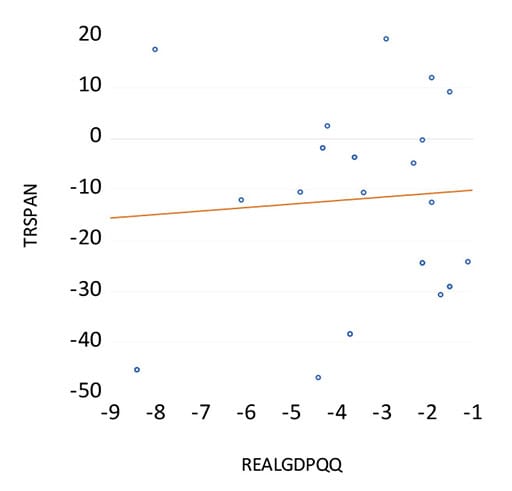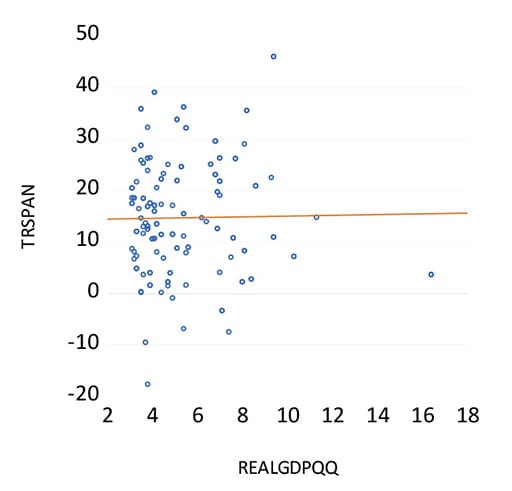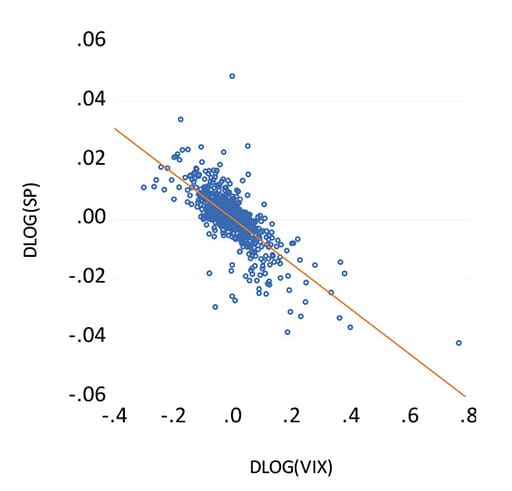Receive Focus insights straight to your inbox
PODCAST with Prof. Brian Kantor
Stock market investors pay close attention to the state of the US economy. Recent moves illustrate this: the market moved sharply lower in late December on fears of a US slowdown. More recently it’s bounced back strongly, as the outlook became less threatening once the Fed shared some of the market anxieties and indicated it would not be raising short-term interest rates.
This raises a question: could you make a fortune buying or selling shares by accurately forecasting US GDP growth rates over the next few years? The answer is a highly qualified yes. It would take a major surprise (to others) of very fast growth to deliver above average returns in the stock market or, just as surprising to others, very slow growth to deliver unusually poor returns.
Rare events
Such phases of very fast or very slow growth, that presumably confound the forecasters and investors, have been very rare. Since 1967 there have only been seven recessions in the US. There have been about the same number of so-called technical recessions – defined as two or more consecutive quarters when real GDP declined.
I count 20 quarters since 1967 when GDP growth in the US was less than 1% per annum. Average annual returns on the S&P 500 over these low growth quarters was a negative 11.8%. The worst quarter for shareholders was the first quarter of 2009 – the time of the financial crisis – when the market was down 47% on the same quarter a year before.
However, slow growth has not always been bad news for investors. In the first quarter of 1981, when growth fell at a 2.9% rate, the S&P 500 Index was up by 19.4% on a year before. The statistical relationship between growth and returns over these low growth quarters was a generally very weak one, with a simple positive correlation of only 0.07 - not nearly enough to rely upon as an investment policy.
Slow growth quarters in the US: Scatter plot of quarterly growth and annual returns

Source: Federal Reserve Bank of St. Louis, Bloomberg and Investec Wealth & Investment
I’ve also identified 98 quarters when growth in the US was strong (over 3% a year). On average over these quarters, the annual returns averaged an impressive 14.7%. But this high average came with a great deal of variability around it. The best annual return of 46.7% came in the third quarter of 1982 and the worst was -17.7% in the fourth quarter of 1973. The statistical relationship between strong quarterly growth and annual returns is also weak, with a correlation close to zero.
Fast growth quarters in the US: Scatter plot of quarterly growth and annual returns

Source: Federal Reserve Bank of St. Louis, Bloomberg and Investec Wealth & Investment
The statistical relationship between quarterly growth and returns over the entire period of 1967 to 2018 is a weak one. Linear regression equations that plot annual index returns with quarterly growth rates have little explanatory power. Using smoother annual GDP growth rates does little better. R squares of no more than 0.16 indicate that there is much more than growth determining annual or quarterly returns. Accurate forecasts of GDP growth are simply not going to cut the returns mustard.
Only big surprises move the market
The problem for any reliance on patterns of past performance is that the markets are always forward-looking. The well-considered forecasts of the economy and companies will already have helped determine the current value of any company, plus any index average of them. Therefore, only large economic surprises in the GDP numbers can move the market. But anticipating these surprises is mostly beyond the capabilities of the collective of forecasters – who will employ similar methods in evaluating the widely available data that anticipates and makes up the GDP itself. Any surprises are going to surprise the forecasters as much as the market.
However, as recent developments on the share market indicate, what matters over any short period of time in the markets is not so much the forecasts themselves, but the confidence held in these forecasts. These will never be in a constant state. Any additional uncertainty about the state of the economy (less confidence in the forecasts) adds volatility to the market. This means wider daily moves in the market, up and down. And when the market moves through a wider daily range, share prices will move in the opposite direction, in a statistically consistent way.
The impact of risk (changes in the VIX) on S&P returns 2016-2019, correlation -0.74

Source: Federal Reserve Bank of St. Louis, Bloomberg and Investec Wealth & Investment
Such changes in sentiment are not easy to forecast. If they could be reliably anticipated, this would undoubtedly be wealth enhancing to the forecaster (or rather, sage). They are, however, best ignored by long-term investors.
About the author

Prof. Brian Kantor
Economist
Brian Kantor is a member of Investec's Global Investment Strategy Group. He was Head of Strategy at Investec Securities SA 2001-2008 and until recently, Head of Investment Strategy at Investec Wealth & Investment South Africa. Brian is Professor Emeritus of Economics at the University of Cape Town. He holds a B.Com and a B.A. (Hons), both from UCT.
Receive Focus insights straight to your inbox




